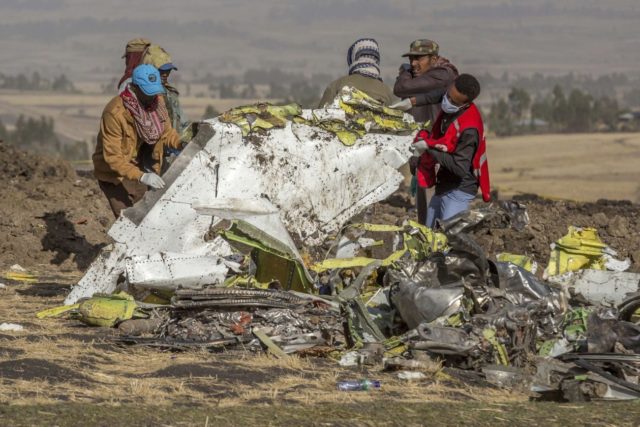The scene of the Ethiopian Airlines flight crash near Bishoftu, south of Addis Ababa, Ethiopia, earlier in March. PHOTO: MULUGETA AYENE/ASSOCIATED PRESS
| Andy Pasztor and Andrew Tangel
The emerging consensus is the strongest indication yet that the same MCAS system misfired in the fatal Ethiopian and Indonesian flights
The emerging consensus among investigators, one of these people said, was relayed during a high-level briefing at the Federal Aviation Administration on Thursday, and is the strongest indication yet that the same automated system, called MCAS, misfired in both the Ethiopian Airlines flight earlier this month and a Lion Air flight in Indonesia, which crashed less than five months earlier. The two crashes claimed 346 lives.
The preliminary finding from the “black box” recorders of Ethiopian Airlines Flight 302 is subject to revisions, according to the people briefed on the matter. U.S. government air-safety experts have been analyzing details gathered from Ethiopian investigators for the past few days, according to one of the people. A preliminary report from Ethiopian authorities is expected within days.
Investigators have been homing in on the MCAS as a potential cause in both of the recent crashes. Ethiopia’s Transport Minister Dagmawit Moges previously said earlier readings from black-box data showed “clear similarities were noted” between both fatal flights.
Earlier this week, federal transportation officials during hearings defended the government’s response to the two crashes, even as questions grew about how the jet was certified for commercial use.
Acting FAA Administrator Daniel Elwell told a Senate panel that there had been no flight tests of the 737 MAX to gauge how pilots would react in the event that a malfunctioning sensor triggered the automated system.
Boeing on Wednesday outlined its planned overhaul of the MCAS system to make it less aggressive and more controllable by pilots. The changes include an added layer of protection: Instead of relying on a single sensor indicating the angle of the plane’s nose, MCAS will rely on data from both of the plane’s sensors. As part of the fix, the FAA also will mandate certain cockpit alerts about incorrect sensor data.
While Boeing has noted investigators haven’t reached final conclusions about what caused either crash, Mike Sinnett, vice president of product strategy, said Wednesday the plane maker had “complete confidence that the changes we’re making would address any of these accidents.”
Roddy Guthrie, the 737 fleet captain for American Airlines Group Inc., said that with the MCAS fix, “They’ve put some checks and balances in the system now that will make the system much better.”
However, Boeing’s 737 MAX will remain grounded around the world until the FAA and other aviation regulators certify the software fix and crews are trained on the revised system.
That process could stretch for months in some countries, regulators and safety officials have said.

























